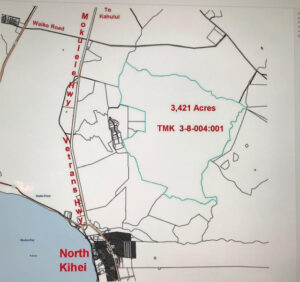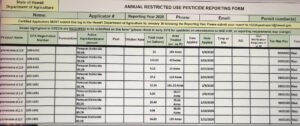The use of the paraquat-containing herbicide Gramoxone on Maui should drop dramatically in 2021, thanks to Mahi Pono’s decision last year to stop spraying it on weeds. However, prior to its halt, Maui’s largest landowner sprayed some 240 gallons of Gramoxone eight times on 974 acres of its 1,195-acre field at the intersection of the heavily-used Haleakala and Hana Highways from January to May, 2020. It sprayed an additional 21 gallons on 185 acres around Hawaiian Cement close to North Kihei on June 8, 2020.
The information is contained in the Hawaii Department of Agriculture’s [HDOA] annual Restricted Use Pesticides [RUP] report—mandated by a 2018 law–that details the use of agricultural chemicals not available for public use. RUP chemicals must only be applied by licensed applicators. Each year, all RUP treatments must be reported to the HDOA by the end of January. Politics on Maui recently obtained the 415-page Maui County portion of the 2020 report through a Uniform Information Practices Act (UIPA) request to the HDOA’s Pesticides Branch. [Mahi Pono’s reports are contained here on pages 27-29 The other three parts of the report are here, here and here.]

Mahi Pono’s 261-gallon total applications of Gramoxone comprised the bulk of the 343.10 gallons of paraquat used in Maui County in 2020. According to the RUP report, only two other farms sprayed the herbicide, which has been linked to Parkinson’s Disease and is banned in many countries, though not the United States. Loe Farms used 6.76 gallons of Gramoxone on its Kula farm in 2020, and Akea Farms used 75.34 gallons on its Molokai fields.
When Loe Farms owner Louis Escovedo was contacted about his Gramoxone use, he called the 6.76 gallons “a very small amount.” Escovedo said he “didn’t know” about the issues involved in paraquat use and that he would “stop if it was dangerous.” Larry Jefts, listed as the owner of Akea Farms, did not return a call about the 90-plus times he sprayed Gramoxone on his Molokai fields last year. Mahi Pono’s Shan Tsutsui also did not respond to an email asking about his employer’s decision to terminate its Gramoxone use.
The three entities’ 2020 spraying of 343.10 gallons of Gramoxone on 1,474.88 acres on Maui, while unacceptable to paraquat opponents, was far less than on Oahu or Hawai’i Island. Oahu farms sprayed 1,143.43 gallons of Gramoxone on 3,279.26 acres in 2020; Hawaii Island farms sprayed 849.33 gallons on 4,261.64 acres. On Kauai, 66.61 gallons of Gramoxone was sprayed on 244.45 farm acres, according to the HDOA’s 2020 RUP use summary report. Without spraying by Mahi Pono, the island’s paraquat use could drop below 80 gallons this year, based on the summary.
Mahi Pono and Paraquat
I first reported on Mahi Pono’s paraquat use in January and March of 2020. Mahi Pono, owned by Canada’s Public Sector Pension Investment Board, purchased 41,000 acres of former sugarcane fields from Alexander & Baldwin in December, 2018. Although in January 2020, then Senior Vice-President of Operations Shan Tsutsui ballyhooed Mahi Pono’s decision to stop using Roundup, the company refused to publicly acknowledge or explain its paraquat use. In those stories, experts questioned Mahi Pono’s description of its farming methods as “sustainable agriculture,” given its use of paraquat and other restricted use pesticides such as cyfluthrin (contained in Bayer’s Baythroid product) on its fields. Subsequently, Maui County district health officer Dr. Lorrin Pang–speaking unofficially in his capacity as a former public health advisor to the World Health Organization and the U.S. Congress–advised Mahi Pono, “Quit spraying stuff.”

While it would be terrific to credit Pang (or my reporting) for Mahi Pono’s decision to halt its paraquat use, that doesn’t seem to be the case. The company, whose manufactured Hawaiian name means “to grow or cultivate responsibly,” sprayed paraquat six times in January and February 2020, and an additional three times through June 8, including 123 gallons applied to 330 acres of the Haleakala/Hana field on May 15. After spraying a final 21 gallons on the field near North Kihei on June 8, the paraquat spraying stopped, with no announcement or fanfare.
It wasn’t until I wrote Tsutsui, now Mahi Pono’s Chief Operating Officer, about a 240 gallon paraquat purchase made in January 2020 that I was informed by the company’s Oahu-based PR firm that “Mahi Pono has moved completely away from using Gramoxone.” The email, sent in December, added that the company had begun to install weed mats in its fields. Beyond that email, the company has inexplicably still not publicized what would be a welcome change to its agricultural practices.
Paraquat is at its most dangerous and toxic while being sprayed on a field. In its 2019 RUP report to the HDOA, Mahi Pono reported the times and dates that it applied Gramoxone, although supplying the time is an option. That year, the company applied 62.5 gallons of Gramoxone to 287 acres of Central Maui fields near the Maui Baseyard. Given manufacturer Syngenta’s strict warning about wind speeds during the application process, I reviewed those reports and found that wind speeds often exceeded the recommended limit when Gramoxone was applied.
In its 2020 RUP report, Mahi Pono omitted all application times. That makes it impossible to determine whether the 2020 applications of Gramoxone (or any other RUP the company used) fell within recommended wind speed limits, which would limit drift away from target areas. Eight of those nine 2020 applications were made on a field bordered by two of Maui’s most heavily trafficked roads. The field has since been planted with citrus trees, according to Mahi Pono’s website.
Its continued lack of transparency aside, the company’s paraquat cessation decision is to be welcomed. Does that now qualify Mahi Pono as a “sustainable agriculture” operation? Sadly no. It still uses the RUPs Agri-Mek, Baythroid, Coragen, Dual II Magnum, Mustang Maxx and Warrior II. These products are, according to their use labels, “highly toxic to bees,” (Agri-Mek, Mustang Maxx, Warrior II), “wildlife” (Agri-Mek, Warrior II), “toxic to fish and aquatic organisms” (Agri-Mek, Baythroid, Coragen), and have the “potential to leach through soil into ground water” (Dual II Magnum). All are subject to strict wind speed restrictions to prevent drift—a very difficult proposition on our island.



Definitely not Pono…run off to our oceans
Bee killing and future diseases in our community
It is a dishonor for them to use the sacred word “Pono”
Another fine article informing us about the continued dangers of chemical agriculture. There’s nothing pono about using poisons: it’s a danger to the farmworkers, the human environment, to bees and other living creatures. These poisons have also been found to leach into groundwater, eventually leaching out into the near-shore environment damaging reefs and aquatic life.
Thanks Deborah for your thorough investigations